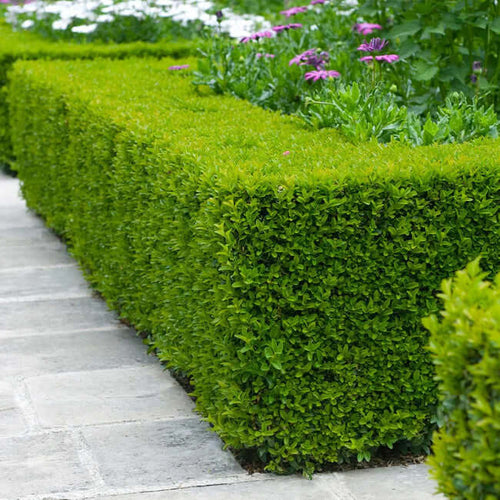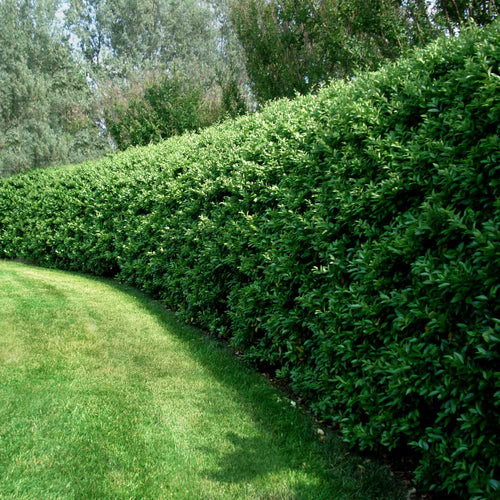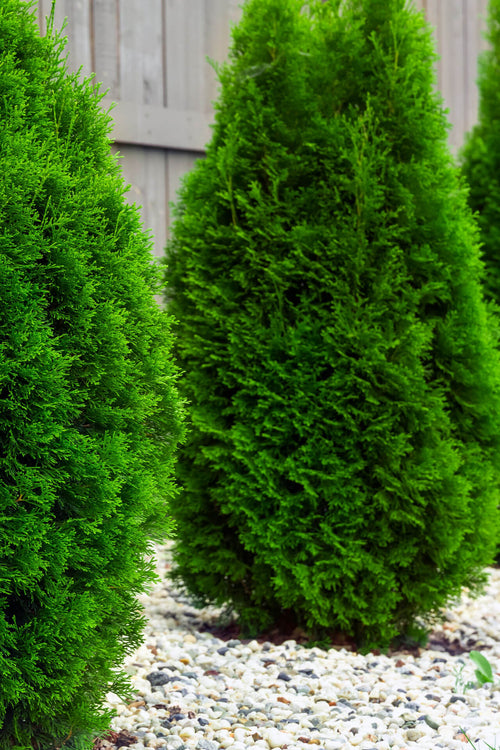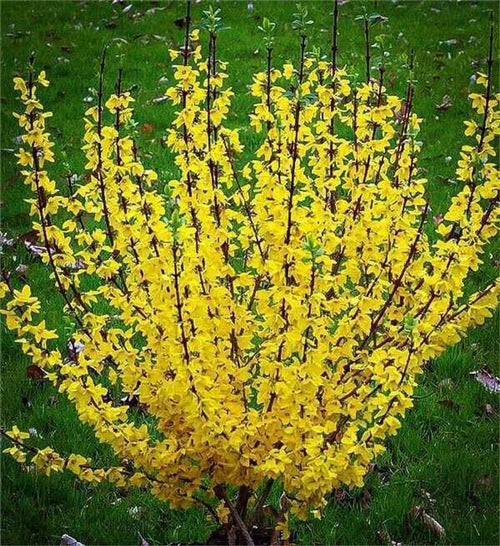A well-designed garden is a sanctuary that provides tranquillity and aesthetic appeal to your outdoor space. With its versatile nature, hedges offer an excellent solution to enhance your garden's charm while serving functional purposes such as privacy, noise reduction, and wind protection.
This article will explore 10 hedge options to transform your home garden into a haven of natural beauty and privacy.
Boxwood (Buxus Sempervirens)
Boxwood is a classic choice for creating formal hedges due to its dense, evergreen foliage and ability to be pruned into various shapes. Its growth habit makes it ideal for creating precise boundaries and topiaries. Boxwood's rich green leaves bring an elegant touch to any garden, whether a low border or a high hedge.
Leyland Cypress (Cupressocyparis Leylandii)
The Leyland Cypress is an excellent option for those seeking a fast-growing hedge. Its rapid growth rate and feathery foliage make it practical for creating privacy screens. However, regular trimming is essential to maintain its shape and prevent overgrowth. This hedge is perfect for gardeners looking to establish a green barrier quickly.
Privet (Ligustrum Vulgare)
Privet hedges are known for their adaptability to various soil conditions and ability to thrive in both sun and partial shade. With semi-evergreen or deciduous varieties, privet hedges can be a versatile addition to your garden. Their dense foliage provides excellent privacy and can be pruned to the desired height.
Yew (Taxus Baccata)
Yew hedges are revered for their longevity and ornamental value. Their dark green needles and red berries add a touch of elegance to any landscape. Yews can be pruned into intricate designs or maintained as natural screens.
Hornbeam (Carpinus Betulus)
Hornbeam hedges offer a unique texture with their serrated leaves that turn a beautiful yellow-orange in the fall. These hedges are often used to create an informal, relaxed boundary. With the ability to tolerate heavy pruning, hornbeam hedges can be maintained at various heights while retaining their visual appeal.
Rose (Rosa spp.)
While less conventional than other hedge options, roses can be trained into beautiful flowering hedges. They provide a fragrant and colorful addition to your garden. Varieties like the rugosa rose are particularly suited for hedging due to their dense growth and ability to withstand pruning.
Beech (Fagus spp.)
Beech hedges are known for their stunning copper-colored leaves in the spring and their ability to retain leaves throughout the winter months. This characteristic makes them effective year-round privacy screens. Beech hedges can be maintained through regular pruning to encourage dense growth.
Arborvitae (Thuja Occidentalis)
Arborvitae, or Thuja or cedar, is famous for evergreen hedges. With various cultivars available, you can choose the height and shape that suits your garden. Arborvitae hedges create a consistent green backdrop and are often used to block out unwanted views or noise.
Forsythia (Forsythia spp.)
Forsythia hedges bring a burst of color to early spring with their vibrant yellow flowers. While they are not evergreen, their dense growth habit can still provide privacy during the warmer months. Forsythias are an excellent option for gardeners, combining flowering beauty with functional hedging.
Japanese Holly (Ilex Crenata)
Japanese holly is a versatile hedge option that can mimic the look of boxwood with smaller leaves. Its compact growth and adaptability to pruning make it suitable for various garden styles. Japanese holly is also well-suited for creating intricate topiaries and formal designs.
Selecting Hedges for Your Home Garden
Whether you prioritize privacy, aesthetic appeal, or a combination of both, there's a hedge species that can fulfill your garden's needs. From the classic charm of boxwood to the vibrant blossoms of forsythia, each hedge option brings unique characteristics to your outdoor space.
By carefully considering factors such as growth rate, maintenance requirements, and overall design goals, you can create a stunning hedge that enhances your garden and offers a sense of seclusion and beauty. In outdoor landscaping and design, hedges have long been prominent, offering a unique blend of natural tranquillity and aesthetic appeal.
These lush, verdant boundaries are not merely functional partitions but also artistic expressions that transform ordinary spaces into captivating havens.
Historical Origins of Hedge Shrubs
The use of hedges in outdoor design traces back centuries, with origins rooted in various cultures across the globe. The ancient Romans and Greeks employed hedges to delineate property boundaries and create private retreats, often adorning them with sculptures and decorative elements.
In medieval Europe, intricate knot gardens featuring meticulously pruned hedges flourished as symbols of wealth and status, while Japanese Zen gardens incorporated hedges to foster contemplation and harmony. The enduring appeal of borders lies in their ability to seamlessly blend history with modernity, offering a timeless connection to the past while enhancing contemporary outdoor aesthetics.
Endless Hedge Design Possibilities
Hedges, with their diverse range of species and growth habits, offer an unparalleled canvas for creative expression in outdoor design. From the classic elegance of tightly manicured boxwood hedges to the untamed beauty of informal private barriers, there exists a broad spectrum of options to cater to various design preferences.
The height and density of walls can be tailored to create secluded nooks within more significant landscapes, inviting occupants to escape the hustle and bustle of daily life. Additionally, hedges can be shaped into artistic forms, adding a sculptural element that transforms greenery into living art. The play of light and shadow through the leaves and branches of hedges further contributes to the dynamic visual impact they bring to outdoor spaces.
The Nature-Inspired Tranquility of the Hedge Shrubs
Hedges have an innate ability to evoke a sense of tranquility by connecting outdoor spaces with the natural world. As a living barrier, they gently buffer the surroundings from external disturbances, creating a serene atmosphere that brings relaxation and contemplation. The rustling of leaves in the breeze, the subtle fragrance of blossoms, and the soft diffusion of sunlight through the foliage all contribute to a sensory experience that soothes the mind and uplifts the spirit.
Whether positioned as a backdrop to a contemplative seating area or as a defining feature of a garden pathway, hedges infuse outdoor spaces with an organic calm that is inherently therapeutic.
Hedges Are Ever-Changing Throughout the Seasons
As the year unfolds, hedges transition through a kaleidoscope of colors and textures. The lushness of summer sees borders at their peak, providing optimal privacy and visual delight. As autumn arrives, the leaves transform into a symphony of warm hues, adding a touch of nostalgia and drama. Even in winter dormancy, hedges retain their form, offering an architectural elegance that starkly contrasts the frosty surroundings. This seasonal metamorphosis ensures the outdoor space is a dynamic and ever-evolving sanctuary for the senses.
Maintenance of Hedge Shrubs
While the appeal of hedges is undeniable, their maintenance is a critical factor in preserving their beauty and functionality. Regular pruning and shaping are essential to maintain the desired form and prevent overgrowth. Strategic trimming not only ensures a neat appearance but also encourages healthy growth.
Adequate watering and fertilization support the hedge's vitality, while pest control measures safeguard against potential threats. Balancing meticulous care and a more naturalistic approach is essential, as too-manicured walls might lose some of their organic charm.
The Environmental Benefits of Evergreen Shrubs
Beyond their aesthetic contribution, hedges offer several environmental advantages that make them an asset to any outdoor space. As natural windbreaks, they shield gardens and homes from solid winds, reducing energy consumption by mitigating heat loss.
Hedges also play a vital role in preventing soil erosion, as their intricate root systems stabilize the soil. Moreover, these green barriers serve as habitats for various bird species and pollinators, enhancing biodiversity and promoting a healthier ecosystem. By absorbing carbon dioxide and releasing oxygen, hedges contribute to cleaner air and a more sustainable environment.
Hedges transcend mere landscaping elements; they embody tranquility and aesthetic allure. Their historical significance, versatile design possibilities, and ability to create a peaceful sanctuary in outdoor spaces make them indispensable components of landscape architecture.
As each season unfurls its unique beauty and the hedge's leaves whisper tales of time, the outdoor space becomes an ever-changing gallery of nature's artistry. The careful balance of cultivation and appreciation ensures that barriers continue to grace outdoor spaces with their enchanting presence, inviting individuals to immerse themselves in the serene embrace of their verdant elegance.
Visit our online shop for a wide selection of plants and trees, or come say hi at our store location in Tennessee!
We offer fast shipping nationwide so you can start transforming your garden today!
If you have any questions about hedges or if you have any other plant needs, don’t hesitate to contact us at customerservice@tennesseewholesalenursery.com, we’d love to hear from you!





















































